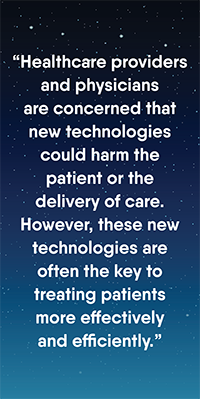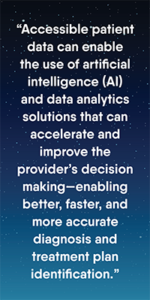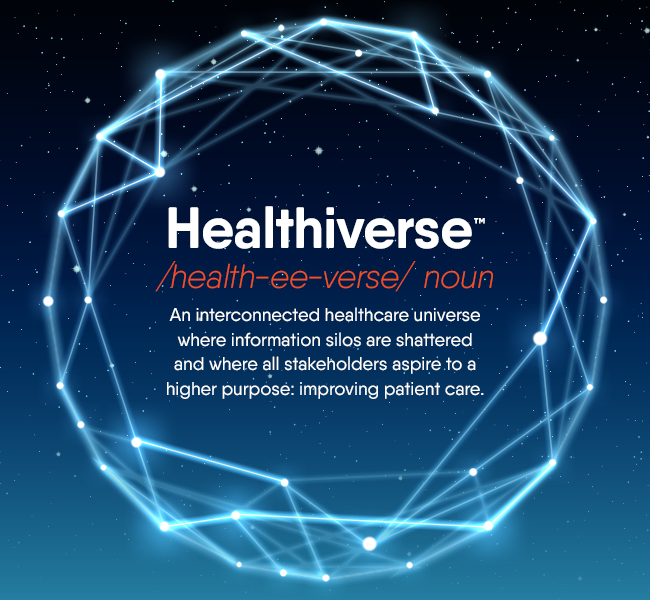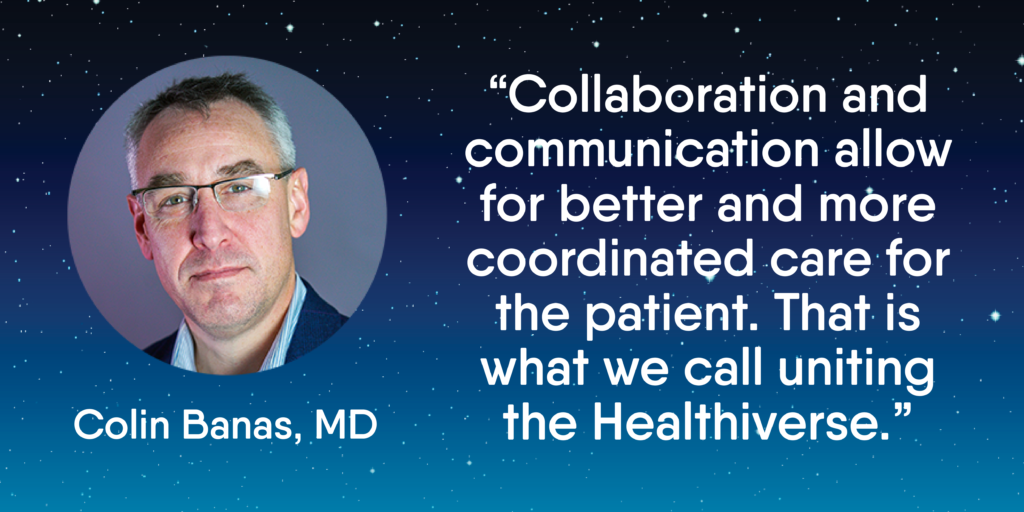Colin Banas, M.D., M.H.A.
The Healthiverse and Healthcare Providers – Meeting Post-Pandemic Challenges
This blog is part of a series introducing the concept of the Healthiverse, explaining why it’s essential to eliminate the siloes between care team members, and exploring the benefits that a more united healthcare universe can deliver to different key stakeholders in the industry.
Healthcare providers have long struggled with the siloes, lack of information sharing, and scarcity of communication that have existed between members of the care team. These issues have plagued the healthcare industry for decades with much work still necessary to resolve them.
But today’s healthcare providers are encountering new challenges in addition to these old problems. They are facing a global pandemic head-on. The ongoing COVID-19 pandemic is forcing them onto the frontlines of an increasingly difficult battle, all while they are struggling financially and personally in the face of new competition, decreasing revenues, and increasing pressure.
New competitors, less business, more burnout
While coronavirus cases are increasing across the country, the patient interactions that providers rely on most for revenue are decreasing. Due to lack of insurance or fears associated with the pandemic, people are delaying elective procedures and thinking twice about seeing their physicians. Operating room minutes are down by 60 percent from this time last year. Visits to emergency departments are down 42 percent from this time last year. That doesn’t mean that people are healthier than they were last year. It means that they are not seeking treatment for their conditions.
The loss of these revenue-generating elective procedures and wellness visits is having a profound economic impact on healthcare providers. That economic impact is being worsened by another trend that we are seeing in the industry – a new influx of competitors that are nontraditional players in the healthcare marketplace.
We’re seeing large retail chains such as Walmart and Amazon starting to enter the healthcare industry. Many of these are large retailers with national or global brand recognition and reputations for offering discounted and low-cost products and solutions to consumers. These companies have incredible resources and capital at their disposal. They also have the ability to offer convenience to patients who are now able to access healthcare services, pharmaceuticals, and retail products all in one place and in the same visit.
These trends often result in providers having to shutter their practices. Many older physicians are using this business environment as justification for retirement. That means that the current and well-known provider shortage is only getting worse, and at the absolute worst time. When all of these patients that have deferred getting treatment finally emerge, post COVID, looking for care, they will have fewer providers to treat them. And, putting off care most likely made their conditions worse.

Also, our society’s larger, aging population is resulting in physician burnout caused by having to see more patients, and more involved cases, in less time. This is exasperated by the fact that there are many burdens placed on the provider. Often, the requirements to meet regulations, document everything, stay on top of billing, and keep the doors open falls on the physicians. This has only intensified during the COVID era.
Providers are human and they’re feeling many of the same pressures and concerns that the average American is feeling during this ongoing pandemic. Many are socially isolated, and some are even quarantined away from families for fear of infecting loved ones. All of this adds up to an incredible amount of mental strain and fatigue for providers – and burnout breeds mistakes, which negatively impacts patient outcomes.
So, what can, and should, providers do to fight back against these challenges? How can they overcome burnout, compete in an increasingly competitive marketplace, and weather the revenue shortfalls resulting from COVID?
Embracing technology for teamwork
Healthcare, as an industry, tends to lag ten-to-twenty years behind other industries. Often for a very good reason. Healthcare providers and physicians are concerned that new technologies could harm the patient or the delivery of care. However, these new technologies are often the key to treating patients more effectively and efficiently.
I once worked in a complex care clinic where patients would be managed and treated by a doctor, a pharmacist, mental health resources, social workers, nurses, and other care team members. This multidisciplinary team approach to care resulted in significantly better outcomes overall for the patient. This also took a large part of the burden off of the physician since they weren’t being relied upon to do the work of multiple different healthcare professionals. In fact, everyone was working at top of license and it was better for everyone, especially the patient.
In this environment, the care team was what it really should be…a team. But this is only possible if all stakeholders can share information, interact, and communicate easily and effectively.
Fortunately, new technologies are breaking down the silos between the care team members. Eliminating the interoperability issues between systems and applications being used across the care team continuum, and increased opportunities for them to more effectively share patient data, are key contributions to this emerging technology set. Collaboration and communication allow for better and more coordinated care for the patient. That is what we call uniting the Healthiverse.
More efficient, more profitable
 With new competition from retail giants lurking on the horizon, it is essential that healthcare providers find ways to differentiate themselves. Likewise, providers must find ways to increase their efficiency so that they can maximize both their revenue and their profits. New technologies can help accomplish all of those things.
With new competition from retail giants lurking on the horizon, it is essential that healthcare providers find ways to differentiate themselves. Likewise, providers must find ways to increase their efficiency so that they can maximize both their revenue and their profits. New technologies can help accomplish all of those things.
Greater efficiency is an appropriate first goal for providers. Today’s new technologies can bring the right information to the point of care and intervention at the right time. They can deliver accurate medication lists in a consumable format. They can curate and format data to present it to the care team in a way that minimizes the need to leaf through extraneous or duplicate forms or files trying to find the right info. Instead, just the most important and necessary patient and medication data is served up exactly when it is needed allowing actionable insights and enabling more informed decisions.
Should complete patient data and information be available and accessible, that also opens the door to advanced technologies. Accessible patient data can enable the use of artificial intelligence (AI) and data analytics solutions that can accelerate and improve the provider’s decision making – enabling better, faster, and more accurate diagnosis and treatment plan identification.
The increased adoption of telehealth that has resulted from the COVID pandemic is also a trend and technology that can benefit providers. Telehealth makes it easier and more convenient for patients, resulting in less canceled appointments and more frequent visits. With no travel required, patients are also more punctual. Telehealth is also incredibly efficient, allowing providers to fit more patient interactions into a single day, while ensuring patient data access is simple, secure, and meets all federal healthcare privacy requirements and regulations.
I fully anticipate that telehealth will become the new normal for healthcare in the not-too-distant future. Those that do not offer telehealth and the tools and resources needed to effectively manage digital patient data and interactions will be left behind by those that do.
Today’s healthcare providers are struggling against significant and unique challenges while trying to deliver positive outcomes for patients, often without all of the necessary information required. They are facing new competitors in the healthcare industry. And, they are seeing their revenues decrease as a pandemic keeps patients away. Thankfully, new technologies can help them unite the Healthiverse, increase information sharing, improve their efficiency and efficacy, and drive increased revenue in a time of uncertainty and increased competition.
Learn more about the Healthiverse and how new technologies are making all members of the care team more collaborative, informed, and connected.

The “Healthiverse” is a term coined by DrFirst to describe our vision of a united healthcare universe where everyone is connected in real-time to each other and to the information they need, so patients get the best care.


















